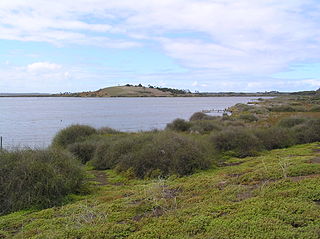
The platypus, sometimes referred to as the duck-billed platypus, is a semiaquatic, egg-laying mammal endemic to eastern Australia, including Tasmania. The platypus is the sole living representative or monotypic taxon of its family Ornithorhynchidae and genus Ornithorhynchus, though a number of related species appear in the fossil record.

The fauna of Australia consists of a large variety of animals; some 46% of birds, 69% of mammals, 94% of amphibians, and 93% of reptiles that inhabit the continent are endemic to it. This high level of endemism can be attributed to the continent's long geographic isolation, tectonic stability, and the effects of a unique pattern of climate change on the soil and flora over geological time. A unique feature of Australia's fauna is the relative scarcity of native placental mammals. Consequently, the marsupials – a group of mammals that raise their young in a pouch, including the macropods, possums and dasyuromorphs – occupy many of the ecological niches placental animals occupy elsewhere in the world. Australia is home to two of the five known extant species of monotremes and has numerous venomous species, which include the platypus, spiders, scorpions, octopus, jellyfish, molluscs, stonefish, and stingrays. Uniquely, Australia has more venomous than non-venomous species of snakes.

The Chiltern-Mt Pilot National Park is a national park that is located in the Hume region of Victoria, Australia. The 21,650-hectare (53,500-acre) national park is situated approximately 275 kilometres (171 mi) northeast of Melbourne, and extends west from Beechworth across the Hume Freeway and the Albury-Melbourne railway line to the west of Chiltern.

Eungella National Park is a protected area in Queensland, Australia. It is on the Clarke Range at the end of the Pioneer Valley 80 km west of Mackay, and 858 km northwest of Brisbane. Eungella is noted for the national park which surrounds it. It is considered to be the longest continual stretch of sub-tropical rainforest in Australia. The original inhabitants are the Wirri people. The park is covered by dense rainforest and is known for its platypuses.

Healesville Sanctuary, formally known as the Sir Colin MacKenzie Sanctuary, is a zoo specialising in native Australian animals. It is located at Healesville in rural Victoria, Australia, and has a history of breeding native animals. It is one of only two places to have successfully bred a platypus, the other being Sydney's Taronga Zoo. It also assists with a breeding population of the endangered helmeted honeyeater.

The regent honeyeater is a critically endangered bird endemic to southeastern Australia. It is commonly considered a flagship species within its range, with the efforts going into its conservation having positive effects on many other species that share its habitat. Recent genetic research suggests it is closely related to the wattlebirds.

The rakali, also known as the rabe, the "Australian Otter" or water-rat, is an Australian native rodent first scientifically described in 1804. Adoption of the Aboriginal name rakali is intended to foster a positive public attitude by Environment Australia.

The yellow-tufted honeyeater is a passerine bird found in the south-east ranges of Australia. A predominantly black and yellow honeyeater, it is split into four subspecies.
CSIRO Publishing is an Australian-based science and technology publisher. It publishes books, journals and magazines across a range of scientific disciplines, including agriculture, chemistry, plant and animal sciences, natural history and environmental management. It also produces interactive learning modules for primary school students and provides writing workshops for researchers.

The helmeted honeyeater is a passerine bird in the honeyeater family. It is a distinctive and critically endangered subspecies of the yellow-tufted honeyeater, that exists in the wild only as a tiny relict population in the Australian state of Victoria, in the Yellingbo Nature Conservation Reserve. It is Victoria's only endemic bird, and was adopted as one of the state's official symbols.

The painted honeyeater is a species of honeyeater in a monotypic genus.

The grey-headed honeyeater is a species of bird in the family Meliphagidae. It is endemic to Australia.

Lake Connewarre State Wildlife Reserve (LCSWR) is a 3411.1 ha Park in Victoria, Australia, that contains a diverse range of unique and significant ecosystems including a river, tidal delta, lakes, swamps, salt marshes and grasslands.

The Paroo-Darling National Park is a protected national park that is located in the Far West region of New South Wales, in eastern Australia. The 178,053-hectare (439,980-acre) national park spans two distinct regions in the outback area. This region covers the arid catchments of the Paroo River and the Paroo-Darling confluence to the south.

Established in 1965, the Yellingbo Nature Conservation Reserve is located 45 km east of Melbourne in the Upper Yarra Valley, near the towns of Yellingbo, Launching Place, Yarra Junction, Hoddles Creek, Cockatoo, Emerald, Monbulk and Seville. Yellingbo Nature Conservation Reserve is a narrow riparian reserve with stream-frontage land along the Woori Yallock, Shepherd, Cockatoo, Macclesfield and Sheep Station Creeks.

Reedy Lake, historically also known as Lake Reedy, is a shallow 5.5-square-kilometre (2.1 sq mi) intermittent freshwater lake or swamp on the lower reaches of the Barwon River, on the Bellarine Peninsula southeast of Geelong in the Australian state of Victoria.
The Warby-Ovens National Park is a national park located on the lands of the Bangerang clan of the Yorta Yorta Nation in the Hume region of Victoria, Australia near Killawara. The 14,655-hectare (36,210-acre) national park is situated approximately 10 kilometres (6.2 mi) west of Wangaratta and 240 kilometres (150 mi) northeast of Melbourne.

The Murray-Sunset, Hattah and Annuello Important Bird Area comprises 7004 km2 of mallee habitat in the Mallee region of north-western Victoria, Australia.
Lindy Lumsden is a principal research scientist with the Department of Environment, Land, Water and Planning, at the Arthur Rylah Institute for Environmental Research, in Melbourne, Australia.
David Cleland Paton is a conservation ecologist, ornithologist, academic, and author. He is an Adjunct Associate Professor of the School of Biological Sciences at the University of Adelaide and Director of Bio-R, which is an Adelaide-based nonprofit organization. He also co-founded the non-profit organization, Arid Recovery.

















